- 1The ACVL Project, The Linguistic Society of Morocco, Mohammed V University, Rabat, Morocco
- 2Department of Modern Languages and Literatures, King Abdulaziz University, Jeddah, Saudi Arabia
The paper provides a novel motivation in favor of a complex and fine-grained syntax of spatial PPs in Arabic. It neatly fills a gap between the complex semantics of spatial expressions and their morphosyntax, which remains unexplained using wide spread cognitive approaches. We propose a fine-grained architecture of root nodes, categories, and features in the basic representations of Path/Place expressions, inspired by cartographic analyses of PPs, but based on a pP dual-projection model, separating the root/lexical part from the functional/categorial part, as in Distributed Morphology (=DM). In so doing, the paper challenges traditional analyses of PPs as projecting a uniform Path over Place structure (with no bifurcating domain separation). It also provides essential ingredients allowing the decomposition of Place and Path words or expressions, including COINCIDENCE, CONTAIN, CONTACT, etc., or syntactic projections such AxPs, DeixPs, DegPs, ScaleP, GoalPs, etc., which play important syntactico-semantic roles in the grammar. Our analysis successfully accounts for complexity of prepositions or spatial expressions, their morphosyntactic alternations, variation, and polysemy.
1 Basic issues
Prepositions have a rich semantic content and can operate in various domains, including space, time, degree, or force dynamics. Their semantics have been widely studied in the literature (Jackendoff, 1983; Herskovits, 1986; Kracht, 2002; Gärdenfors, 2015, among others). Crucially, some of these properties have been shown to be not only semantic (or ontological), but also of syntactic impact on grammaticality and the syntactic structure of PPs in numerous detailed studies (Jackendoff, 1983; Wunderlich, 1991; Zwarts, 1997, 2005; Koopman, 2000; Zwarts and Winter, 2000; Kracht, 2002; Gehrke, 2008; den Dikken, 2003, 2010; Svenonius, 2010). But more syntactico-semantic features remain to be explored. Our contribution aims as refining the granularity of the PP semantic and syntactic structure in spirit of the Cartography approach (typically Cinque, 2010; Svenonius, 2010, 2012; Procházka, 2011), although relying on a Distributed Morphology design (Halle and Marantz, 1993; Wood and Marantz, 2017). We describe some core fragments of the grammar of Arabic PPs along the lines sketched, in contrast to dominant cognitive approaches of Arabic PPs, in which syntax plays only a minor role in structuring prepositional meanings (Lentzner, 1977; Esseesy, 2010; Jan, 2018).
1.1 Places and paths
As in Talmy (1975, 2000), prepositions normally denote a relation between two arguments, Figure and Ground, which express the external and internal arguments, the object located and the reference land mark. Jackendoff (1983) decomposes PPs into his “ontological categories” PLACE or PATH, and a consensus has developed since then on the relevance of two main functional/syntactic categories: Place and Path, as illustrated in the examples in (1).
(1) a. The elephants remained in the boat. (Svenonius, 2006, p. 127)
b. The boat is drifted to Narvik.
In (1a), the PP in the boat is a PlaceP, while the PP in (1b) to Narvik is a PathP. Prepositions that are associated with stative locational meanings project are Place heads while prepositions associated with directional meanings projects are Path heads. This classification is not only semantic but also reflected in syntax. For example, locative PPs can co-occur with stative verbs like be, stay, remain (Gehrke, 2008, p. 87), which select them, but not with directional PPs, as the contrast in (2) shows:
(2) a. The /remained /on /under/ behind the table.
box in
stayed
b. *The /remained /into/ from /out /down/ through
box to of the
stayed table.
In German, locative prepositions govern the dative case ([+OBL]), whereas directional prepositions mostly govern the accusative case ([–OBL]), as in (3) (Bierwisch, 1996, p. 32):
(3) a. Er schwamm unter dem Steg
He swam under the bridge. locative
b. Er schwamm unter den Steg
He swam under the bridge. directional
In Dutch, locative adpositions are prepositional; whereas directional ones are post-positional (den Dikken, 2010, p. 6):
(4) a. Jan liep/rende in het bos
Jan walked/ran in the woods locative
b. Jan liep/rende het bos in
Jan walked/ran the woods in directional
Structurally, PathP can be seen as more complex than PlaceP, given the fact that PathP cartographically embeds PlaceP, as represented in (4) (Svenonius, 2012, p. 5):
(5) 
1.2 The figure and the ground as p/P arguments
These distinct morphosyntactic properties are best thought as reflecting differences in syntactic structure. In fine-grained syntax, the question arises as to whether the figure F and the ground G are both included in a basic argument configuration type as bi-argumental, as argued for by Hale and Keyser (2002), the P root being dyadic, as in their argument structure type in (6a); [=their structure (17), p. 7], or their schematic argument structure in (6b):
(6) 
Alternatively, G is introduced as a complement of (the big) P (or our root P), and F is indeed the external argument of (small) p, a functional head exactly parallel to v, or more commonly voice, in its ability to license an external argument, as in Wood and Marantz (2017). Ideally, various functional heads can be reduced to one single argument introducer, which is referred to as i*, in distinct syntactic contexts. Differences between different uses of i* stem from rules that are sensitive to the syntactic context in which it occurs. The functional head i* encompasses both p, v, or voice, or other flavors of f-categories. So, in terms of argument-introducing heads, we have two essential traditional distinct heads in (7):
(7) a. Little p (figures): Bare i* merges with PP.
b. Voice (agents): Bare i* merges with vP.
Interpretive differences between the two heads are now understood as contextually determined interpretation rules, as illustrated in (8):
(8) a. [[i*]]↔λxλs. FIGURE(x,s) / ___(locative PP)
b. [[i*]]↔λxλe. AGENT(x,e) / ___(agentive vP)
As for the root of P (or bigP), it is a root-adjoined i* with selectional feature checked by complement. The authors pointed out that they follow basically Svenonius in identifying internal argument with G, and external argument with F of prepositions (pp. 258–261).
While we basically adhere to this line of reasoning concerning the general design of the theory, we will leave the room open for the argument structure in (6) as potential structure of big P in some cases, or of the RootP of the PP, given potential evidence for the existence of both basic intransitive and transitive verb roots that can be causativized, and that the structure of the basic transitive cannot be readily derived from that of the intransitive. Parallel preposition configurations can be potentially found conflated in more complex causative structures.1
1.3 Morphosyntactic complexity
Beside cartographic distribution of Paths and Places, morphological complexity is another property that has been used in English to determine syntactic structure. Prepositions such as in, on, at are simple prepositions, but in front of, under, next to are complex (see Svenonius, 2006, 2010; Cinque, 2010, among others). Moreover, some complex propositions have been argued to contain two more heads: Ax(ial)Part and Case (K), as in Svenonius (2006, 2010):
(9) 
(Svenonius, 2010, p. 131, adapted)
The syntactic structure of Place in (9) goes in line with its semantics. According to Svenonius (2012), in back of and behind both must have the same syntax (i.e., with three heads), although in back of is prosodically three words. Thus, the category labels are often associated with both syntax and semantics. In complex prepositions, Svenonius (2012) proposes that p is higher than AxPart, which introduces the external argument (or Figure). That is to say, the prepositional locative word or structure is decomposed into p, AxPart, and K in complex constructions:
(10) 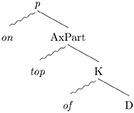
(Svenonius, 2012, p. 10)
A further elaboration of morphosyntactic complexity which is reflected in the structure of PlaceP is the sensitivity to Measure Phrases (MeasP). Only some Place expressions (but not others) are measurable, allowing phrases such as ten meters, twenty feet, a foot etc to occur, as illustrated in (8) and (9) (Svenonius, 2012, p. 16). Svenonius calls this feature Proj(ective), adopting Herskovits (1986) original term of the semantic feature Projective:
(11) a. There's a tree twenty feet in front of the house.
b. There's a wind vane a foot above the house
(12) a. There's a tree (*five feet) beside the house.
b. There's a tree (*a foot) on top of the house.
The (un-)grammaticality is reflected in the structure. Svenonius (2012) argues that projective expressions are endowed with a Proj(ective) feature. Structurally, Proj expressions have an additional projection ProjP that is not available in non-projective expressions. Compare the cartography (10)2 below to the non-Proj structure in (9) above (but see Section 3 below for more discussion):
(13) 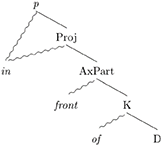
(Svenonius, 2012, p. 16)
Beside Proj, there are other semantic features embodied in the locative expression such as Size, Stability, Outline, Contact, and Motion that remain unexplored. These features are widely discussed in Landau and Jackendoff (1993), Kracht (2008), Herskovits (1986), Gärdenfors (2015), Fassi Fehri (2021), among others, but the question is to what extent these features are reflected in the syntactic structure. We return to the issue in Section 3 for more discussion and refinements.
1.4 Hierarchical paths
Like locative prepositions or places, directional expressions or paths have semantic features that turn out to be also syntactic, suggesting further granularity or finer cartography. Building on work developed by Jackendoff (1983), Piñón (1993), Kracht (2002) and Zwarts (2008), among others, Procházka (2011) identifies three semantico-syntactic types of paths: Goal, Source and Route, structured and ordered cartographically. Moreover, using three aspectual or semantic features (±TRANSITION, ±ORIENTATION, and ±DELIMITATION), these types are further subdivided in eight subtypes, to account for distinctions found in the following constructions, (14) to (16), respectively:
(14) a. They cast a wistful glance to the shore. (Svenonius, 2010, p. 127)
b. saafar-tu ʔilaa d-doḥat-i
traveled-I to Doha-GEN
“I traveled to Doha.”
(15) a. The boat drifted farther from the beach. (Svenonius, 2010, p. 127)
b. ʔamšii min l-bayt-i
walk-I from the-house-
GEN
“I walk to the house.”
(16) a. A band is playing through the trees. (Svenonius, 2010, p. 149)
b. y- ṭ-ṭaaʔir- ḥawl-a š-šajarat-
aḥuum-u u i
3-roam- the-bird- around- the-tree-
IND NOM ACC GEN
“The bird is roaming around the tree.”
Syntactically then, Path is decomposed into three syntactic heads: Source, Goal, and Route (or symmetric Path) (Procházka, 1993, 2011; Nam, 1995). In languages with rich spatial case system such as Daghestanian languages, the three heads manifest a fixed hierarchy: Route>Source>Goal as illustrated in (17): 3
(17) 
1.5 Research questions and significance of the study
The paper aims at answering two essential research questions:
(a) How granular are the morphosyntactic features in Arabic locational and directional expressions, to reach a reasonable degree of descriptive adequacy?
(b) How are these features syntactically represented, given the root/category divide (a basic tenet of DM), and the also potential hierarchical cartography?
Our contribution explores in particular the internal structure of PPs in Arabic. Arabic is targeted as a relatively poorly described language regarding the topic, when compared to the abundant and meticulous studies of Germanic, Romance, or Slavic. This is not denying the existence of important contributions found in tradition grammar, including namely Ibn Hišaam (1985) and Al-Muraadii (1992), or in cognitive descriptions as conducted by Lentzner (1977), Esseesy (2010) and Jan (2018), or the generative analysis developed by Saeed (2014), Fassi Fehri (2021), or previous studies by the authors, on which we are building substantially (see also Procházka, 2011). The article investigates and motivates morphosyntactic features or categories in both locational and directional expressions along their semantic interpretations from both theoretical and cross-linguistic perspectives, and how these features and categories are hierarchically ordered, along the root/category divide in a Distributed Morphology (=DM) design of grammar.
1.6 Our basic analysis
In analyzing the Arabic prepositional or axial (Axpart) noun expressions, we adopt a DM model which takes into account the dual life of spatial expressions, as lexical roots (normally represented by big P), and as functional categories [normally represented by small p; (see e.g., Rooryck, 1996; Marantz, 1997; Deacon, 2011; Wood and Marantz, 2017)]. In DM, lexemes are not formed in the lexicon, before they enter the syntactic derivation. Rather, the necessary aspects of the lexicon are positioned within sentential derivation. The concept of lexeme is replaced by two forms: Lexical Item (LI) and Vocabulary Item (VI). LIs are borne as uncategorial roots (or abstract language specific morphemes), which enter the derivation as simple or complex root nodes, and are categorized through various functional category nodes, which form the terminal nodes in syntax, or constitute interpretable phases. Terminal nodes are provided after the syntactic derivation with a specific phonological form of the word, a VI (see Chomsky, 1995, 2001; Harley and Noyer, 1999; Embick and Noyer, 2005; Marantz, 2013; and Harley, 2014, among many others). As for the fine structure of PPs, our work draws heavily from significant cartographic studies on the topic, including notably Koopman (2000), Svenonius (2010, 2012), Cinque (2010), den Dikken (2010), and Pancheva (2011), among others.
As in Wood and Marantz (2017) for English, and Fassi Fehri (2021) and Fassi Fehri and Alrawi (2023) for Arabic, the structure of PPs is split between the root node(s) and the syntactic f-node(s). In parallel to the vP shell (Larson, 1988, 2014), the pP shell is argued to be a dual projection: a Root √ (the traditional big P) and a categorizing (case assignor or small) p:
(18) 
This structure allows us to elegantly account, among other things, for the categorial flexibility of spatial expressions. They can surface as a preposition, a noun, an adjective, or as a (locative) verb phrase, as illustrated in (19):
(19) a. al-kitaab-u ʕalaa ṭ-ṭaawilat-i
the-book- on the-table-GEN
NOM
“The book is on the table.”
b. ʔazal-tu n-naḥlat-a min ʕalaa dahr-i-ka
removed-I the-bee- from on back-GEN-
ACC your
“I took out the bee from above your back.”
c. nazala l-maaɁ-u min Ɂaʕlaa
came down the-water- from above.GEN
NOM
“The water went down from above.”
d. l-jabal-u Ɂaʕlaa min xams- mitr-in
imiɁat-i
the- higher than five meters-GEN
mountain- hundred-
nom GEN
“The mountain more than five hundred
meters height.”
(lit. “The mountain is higher than five
hundred meters.”)
e. ʕala-t l-miyaah-u l-jabal-
a
went.high- the-water- the-
F NOM mountain-
ACC
“The water went up the mountain.” (after Fassi Fehri and Alrawi, 2023, p. 9)
Thus, the root of ʕalaa “on,” as seen in (20), can surface as p in (20a), n in (20b) or (20), a in (20c), or v in (20d):
(20) 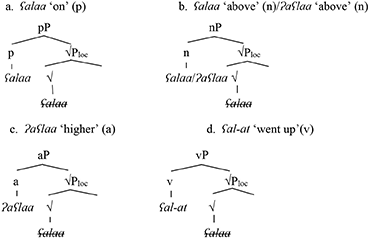
(Fassi Fehri and Alrawi, 2023, p. 9)
Moreover, the lower √Ploc or √Pdir (den Dikken, 2010) is responsible for the distinct locative or directional (or Place/Path) meanings associated with spatial expressions. The c-commanding functional p is the categorizer that assigns genitive case, parallel to v in vP that assigns accusative. Movement of √-to-p is motivated: the interpretable [loc]/[dir] feature makes the spatial expression an appropriate goal probed by p (Fassi Fehri, 2021). In our analysis, the traditional single projection PlaceP is split into two projections: √Ploc and the axial or AxPart nP (see Section 3.1). Similarly, PathP is split into two projections: the root √Pdir rode and the pP categorial node, as represented in (21):
(21) 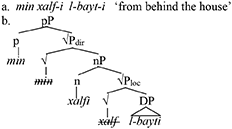
A number of details and motivations can be found in Fassi Fehri and Alrawi (2023), and will not be repeated here. This contribution is an attempt to refine the basic analysis argued for there or in other works on the topic, adding further motivations and clarifications. It focuses chiefly on the granular issue, its syntactic motivation, in addition to elaborating on complexity of prepositions, their polysemy (or allosemy; Marantz, 2013), their homonymy (or allomorphy), as well as dialectal variation.
2 complex polysemies and syntactic alternations
Prepositional phrases are found in complex constructions, polysemies, and dialectal variations. In our system, these phenomena are taken care of by distinct structures, depending on constructions that may or may not be related morpho-syntactically, in association with their semantics. Cognitivists, by contrast, rely on hierarchically ordered cognitive networks that are associated with words (as in Lentzner, 1977; Esseesy, 2010; Jan, 2018). We claim that the hierarchically ordered “word approach” used is inadequate, given that it does not assume a tight correlation between syntactic (or morpho-syntactic) structure and semantics, do not make meaning depending on constructions (but on words), and hence do not make clear predictions about form meaning correlations built in the syntax of languages, or about empirically motivated lexical classes or subtypes behind dialectal variation, as we will explain below.
2.1 meanings of Place with fii and bi-
In traditional grammar, each P is polysemous, although meanings are ordered, starting with basic or primary meanings (Ibn Hišaam, 1985; Al-Muraadii, 1992, among others). Fii has a number of meanings that are instantiations of the “lexical” root P. Chiefly, among those meanings is a broad locative or temporal “circumstantiality”, or more specifically a CONTAINMENT (htiwaaɁ), as illustrated in (22):
(22) a. zayd-un fii d-daar-i
Zayd-NOM in the-house-GEN
“Zayd is in the house.”
b. sa-Ɂuṯri fii biḍʕ-i siniina
FUT-be rich in few-GEN years.GEN
“I will be rich in few years.”
In modern grammars, most Arabic linguists converge on the idea that fii has a broad LOCATIVE meaning, and a more specific meaning of CONTAIN(MENT) that corresponds to those of the English preposition “in,” or more extensively “at” or “on” as illustrated in (23), (24), and (25), respectively (Lentzner, 1977; Esseesy, 2010; Jan, 2018; Fassi Fehri, 2021):
(23) l-jamaaʕat-u fii l-masjid-i
The-group-NOM in the-mosque-GEN
“The group is in the mosque.”
(24) y-atajawwalu fii š-šaariʕ-i
3-walk in the-avenue-GEN
“He walks in theavenue.”
(25) l-qimmat-u fii y-ulyuuz-a
the-summit-NOM in July-GEN
“The summit is in July”
The locative meaning of fii can be partial CONTAIN (rather than total), in which the Ground partially contains the Figure, as in (26).
(26) a. l-ʕuṣfuur-u fii š-šajarat-i
the-bird-NOM in the-tree-GEN
“The bird is in the tree.”
b. l-wardat-u fii l-mazhariyyat-i
the-flower-NOM in the-vase-GEN
“The flower is in the vase.”
The bird in (55a) is not contained by the tree but it is located in one branch of the tree, and only part of its body is attached to the branch. Similarly, in (55b), only part of the flower is located inside the vase (Esseesy, 2010).
Moreover, localization can be broad or abstract, where no physical or concrete containment is infered, as in (27):
(27) ṭanjat-u fii šamaal-i r-ribaaṭ-i
Tangier-NOM in north-GEN Rabat-GEN
“Tangier is to the north of Rabat.”
In (27), there is no concrete physical containment relation between Tangier and Rabat, but only a broad more abstract location, according to which the Figure F is seen as included in the INTERIOR of the Ground G.
In the time domain, fii situates F in a certain G moment in time and means specifically CENTRAL COINCIDENCE in Tense and Aspect. It corresponds to English “at” or “in”, which means that F and G either coincide (i.e., overlap in the positioning in time), as in (28a), or that G is a container inside of which F is temporally located, as in (28b).
(28) a. mawʕid-u-na fii l-xaamisat-i
appointment-NOM- in the-five-GEN
our
“Our appointment is at 5 o'clock.”
b. naḥnu fii l-masaaɁ-i
we in the-evening-GEN
“We are in the evening.”
What is of interest, in particular, is to see whether these two primary meanings of fii- can be confused with those of other close prepositions, typically bi-. As we will see, the essential meanings of the two prepositions can be contrasted, and made distinct, despite the fact that they can overlap, or be confused and made interchangeable.4
The preposition bi- “at, with” is the closest preposition to fii “in.” But according to traditional grammars, its primary meaning is CONTACT (Ɂilsaaq, literally “gluing”, or “sticking”), compared to fii, which is primarily dedicated to CONTAINMENT or INCLUSION. The locational contact meaning is clearly found in the following constructions:
(29) ṣ-ṣuur-at-u laṣiiq-at-un bi-l-ḥaaɁiṭ-i
the-photograph-F- glued-F- at-the-wall-
NOM NOM GEN'
“The photograph is glued to the wall.”
(30) Ɂanaa mutaʕalliq-un bi-ka
I attached-NOM at-you
“I am attached to you.”
In verb complexes, favored by traditional grammar, to vehicle CONTACT, prototypical constructions include the following instances, where a contact is established between me and the man's hand in (31a), or me and the man in (31b):
(31) a. Ɂaxađ-tu bi-yad-i r-rajul-i
took-I at-hand-GEN the-man-GEN
“I took the man's hand.”
b. ltaqayt-tu bi-r-rajul-i
met-I at-the-man-GEN
“I met the man.”
In all these contexts, fii cannot be used instead of bi- in the standard variety of Arabic.5
What is problematic, in traditional descriptions, however, is that they make no room for the general locational meaning that bi- can express, without inducing any inclusion, but still entailing some PROXIMITY or VICINITY meaning, or roundabout (Jan, 2018) as in the following examples:
(32) Ɂanaa bi-baab-i manzil-i-ka
I at-door-GEN house-GEN-
your
“I am by your house door.”
Clearly, the preposition in these examples locates F in some proximity or roundabouts of G, but does not induce any containment or inclusion. The introduction of fii is clearly not an option here. Moreover, the translation of bi- should be “at” rather than “in,” although bi- does not have meanings of “at;” in fact, most of the meanings of the English locative “at,” discussed by Brenda (2015), are rather expressed by fii. This difference clarifies the distinctive interpretation of the PP in the classical (33a), compared to (33b):
(33) a. Ɂinnaka bi-l-waadii l-muqaddas-i, ṭawaa
you at-the- the-sacred-GEN Tawa
valley.GEN
“You are at the sacred valley, Tawa” (Quran, 16).
b. Ɂanaa fii l-waadii
I in the-valley.GEN
“I am in the valley.”
It is possible that both bi- and fii express COINCIDENCE, and that they differ in that fii can be viewed as expressing central COINCIDENCE, whereas bi- expresses non-central COINCIDENCE (see Lentzner, 1977, where fii expresses COINCIDE INTERIOR, compared to bi-, which is not specified for INTERIOR). We propose that CONTACT or non-central COINCIDE(NCE) are the specific meanings of the spatial bi- “at.”
Hale (1986) claims that two essential distinct local cases in Walbiri can be defined along the COINCIDE notion, characterizing the role of F (or theme) with respect to G (or Place), or spatial–temporal relations more generally. Demirdache and Uribe-Etxebarria (2014) extend the notion to include both space and temporality, as in (62):
(34) a. [+ central coincidence]: F within G
Location, trajectory, or linear arrangement of F
centrally coincides with G.
b. [- central coincidence]: F not within G “terminal,”
“initial,” etc. (bi-)
Location, trajectory, or linear arrangement of F
does not centrally coincide with G.
In (34a), the location of the interlocutor coincides with that of the valley, without inducing any containment or inclusion, contrary to (34b).
Fii “in,” on the other hand, locates F in a position interior and within the boundaries of G, a CONTAINMENT, or a CC relation. We assume that what differentiates bi- “at” from fii “in” is the meaning associated with the root, to fit in a suitable construction. Thus, the root of bi- “at” is distinct from that of fii “in,” as schematized in (35); ± CC abbreviating ±: CENTRAL COINCIDE
(35) 
Clearly, bi- does not normally replace fii in Classical or Modern Standard Arabic, although there appear some cases of interchangeability in modern data. In most cases, this is due to dialectal interferences in the diglossic situation of Arabic. Clearly also, there is a quite systematic variation in the dialectal uses, depending on geographical locations, which can be distinguished depending on the two prepositions uses, instantiating vocabulary variation, as we explain in the next subsection.
2.2 Lexical variation as distinct vocabulary
Lexical variation can elegantly be associated with a distributed model in the standard variety or between other varieties. For example, in Mashriqi dialects, bi- “at” replaces fii in denoting CONTAIN (in addition to CC), as in (36a,b) below from Levantine Arabic:
(36) a. Ɂana bi-l-bet b. Ɂana bi-l-bab
I in-the- I at-the-door
house
“I am in the house.” “I am at the house.”
In Maghribi dialects, on the other hand, fii is often generalized, instead of bi (both are reduced to f- and b-), as in Moroccan Arabic (37):
(37) a. Ɂana f-d-dar b. Ɂana f-l-bab
I in-the- I at-the-door
house
“I am in the house.” “I am at the house.”
For containment in time, by contrast, bi- in Mashriqi dialects replaces fii-:
(38) n-tlaaqa bi-l-masaa/bi-l-lail
we-meet in-the-evening
“We meet in the evening/at night.”
(Fassi Fehri, 2021, p. 160)
In Maghribi dialects, on the other hand, f- is used instead of b-, as in Moroccan Arabic (37):
(39) n-tlaaqaw f-l-ʕašiia/f-l-lail
we-meet in-the-evening
“We meet in the evening/at night.”
With perception or contact verbs, Maghribi dialects more often use b-, as in the (b) examples, while Mashriqi dialects use f-, as in the (a) examples:
(40) a. ḥasse-t fiik b. ḥssee-t bi-k
felt.I in-you felt.I at-you
“I felt you”
(41) a. taṣal-t fi-k b. taṣal-t bi-k
contacted-I in-you contacted-I at-you
“I contacted you.”
(42) a. raḥḥab fiy-ya b. raḥḥab biy-ya
welcomed in-me welcomed at-me
“He welcomed me.”
To express MANNER, b- is mostly used in all dialects, rather than f-:
(43) a. ka-n-tkellem b-š-šweyya (Maghribi)
PROG-I-talk with-slow
“I talk slowly.”
b. be-n-t-kallam b-šwayaš (Machriqi)
PROG-we-talk with-slow
“We talk slowly.”
2.3 Morpho-syntactic alternations
Morpho-syntactic alternations play a major role in revealing the “lexical” or root syntax of prepositions, as well as their functional projections in category syntax. Among these alternations are places/paths, transitives/intransitives, causatives, and the various prepositional uses.
2.3.1 Place/path and CC/TC alternations
The preposition fii alternates between being a Place head in space, as in (44a), or state as in (44b), or a Path head when it collocates with a directed motion event such as daxal “enter,” indicating a change of state, as in (45):
(44) a. r-rajul-u fii l-manzil-i
the-man-NOM in the-house-GEN
“The man is in the house.”
b. r-rajul-u fii gaybubat-i-n
the-man-NOM in coma-GEN-N
“The man is in a coma.”
(45) daxala r-rajul-u fii gaybubat-i-n
entered the-man-NOM in coma-GEN-N
“The man entered into a coma.”
It is important to note that this Place/Path alternation results in change from a CC (Central Coincidence) interpretation to a TC (Terminal Coincidence) interpretation, as if the preposition has switched from the equivalent of in interpretation in English to that of into. That suggests in turn that the TC preposition is complex, made of two prepositions, one of which is unpronounced as in Hale and Keyser (2002, p. 222); [structure (39)]. This is reflected in (46)
(46) 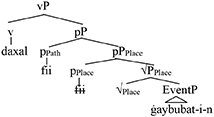
The motion event selects a PathP, when fii collocates with a motion event, it denotes a directional Path, having basically the meaning of the directional Path Ɂilaa, rather than a pure locational Place. This is a case of polysemy of the preposition, involving presumably two distinct syntactic structures (a case of so-called interchangeability of prepositions). It means simply that one preposition (as a vocabulary item, VI) is associated with distinct structures, which are normally associated with two distinct prepositions with some specific senses.
2.3.2 Transitive/intransitive, causative, and alternations
Constructions with Ɂilaa “to” seem to exhibit a prepositional/accusative alternation in which Ɂilaa “to” is either overt or hidden:
(47) a. ṣaʕada r-rajul-u Ɂilaa l-jabal-i
climb the-man- to the-mountain-
NOM GEN
“The man climbed (to) the mountain.”
b. ṣaʕada r-rajul-u l-jabal-a
climb the-man-NOM the-mountain-
GEN
“The man climbed the mountain.”
Ɂilaa expresses a Goal–Path meaning in these constructions, available in both (47a) and (47b), which suggests the presence of a Path root P in both constructions. If so, then the difference appears to be only in the case assignor. The genitive case assignor, p, is available in (47a), but not in (47b). The absence of the structural case assigner p, leaves l-jabal-a “the mountain” in (47b) without case. It is then assigned a sort of oblique “accusative” by default. The two alternations can be represented as follows:
(48) 
Consider now causative alternations. Prepositional/accusative alternations also occur in causative constructions in which the preposition has an overt/null alternation, as illustrated in (49):
(49) a. Ɂ-ahday-tu kitaab-an li-zayd-in
CAUS.gave-I book-ACC to-Zayd-
GEN
“I gave a book to Zayd.”
b. Ɂ-ahday-tu zayd-an kitaab-an <dative>
CAUS.gave-I Zayd-ACC book-ACC
“I gave Zayd a book.”
In both (49a) and (49b), Zayd is the dative or the Recipient of the action. The dative interpretation is assigned by the Goal root √li-. To put it differently, the dative root √li- is assumed to be the source of the dative interpretation, and it is available for both (49a) and (49b). The two constructions then differ only in the source of case assignment. The prepositional p head assigns the genitive case in (49a). But in order for Zayd to receive (structural dative) case in (49b), it moves to a position where it is assigned accusative by v. The examples in (49a) and (49b) are represented in (50a) and (50b), respectively:
(50) 
If (50a) is roughly the basic structure for both constructions in (49), then the dative has to move higher in (50b), adjoining to the pP, to get structural case there.
A further example of an overt/null alternation is illustrated in (51) and represented in (52):
(51) a. kasaw-tu l-walad-a bi-ṯ-ṯawb-i <tool/
instrument>
wore-I the-child- with-the-
ACC cloth-GEN
“I have worn the child with the cloth.”
b. Ɂ-aksay-tu l-walad-a ṯ-ṯawb-a
CAUS-wear- the-child- the-cloth-
I ACC ACC
“I made the child wear the cloth.” (Fassi Fehri, 2021, p. 183)
(52) 
In both (52a) and (52b), ṯ-ṯawb “the cloth” is the tool or instrument used for the action of wearing. In (80a), the causative verb kasaa “made him wear” makes use of the overt preposition bi-, in expressing the Instrument role. The preposition bi- is dominated by the functional p, and it assigns the complement ṯ-ṯawb a genitive case. In (52b), the preposition is silent, and ṯ-ṯawb “the cloth” receives an accusative case via v.
2.3.3 Fii/bi- alternations and inverted roles
Prepositions can have closely related meanings that can relate the same arguments (Figure and Ground) but with different configurational relations. Consider further alternations of fii “in” and bi- “by” in (81):
(53) a. Ɂaṯṯara l-ḥaadi?-u fii r-rajul-i
affected the-accident- in the-man-GEN
NOM
“The accident affected the man.”
b. ta-Ɂaṯṯara r-rajul-u bi-l-ḥaadiṯ-i
REFLEX- the-man-NOM by-the-
affected accident-GEN
“The man got affected by the accident.”
In (53a), l-ḥaadiṯ-u “the accident” is the Figure or the Cause and r-rajul-i “the man” is the complement Ground or the entity affected, as represented in (53a). On the other hand, r-rajul-u “the man” in (53b), which is the Ground, is in the Specifier position, and the Figure l-ḥaadiṯ-i “the accident” is the complement, as represented in (53b). It is true that the selection of the preposition depends on the form of verb, but the relation between the Figure and the Ground is determined by the preposition (or, more specifically, the prepositional root).
(54) 
These alternations suggest the presence of the lexical meaning associated with the P root, regardless of its function as a case assignor.
2.4 Further conflating prepositions in distinct classes or roles
In the verbal domain, when PPs are part of the semantico-syntactic structure of vPs, syntactic alternations are more clearly associated with semantic correlates: CONTAIN, CONTACT, COINCIDE (±central), etc.
2.4.1 CONTACT transitive/PP alternation
Consider the CONTACT transitive/PP alternation associated with bi-:
(55) a. Ɂaxađ-tu bi-yad-i-hi b. Ɂaxađ-tu yad-a-hu
took-I at-hand-GEN-his took-I hand-ACC-
his
“I took (at) his hand.” “I took his hand.”
In (55a), bi- “at” collocates with the verb Ɂaxađ “took”, creating a meaning of CONTACT. This meaning is preserved in the null counterpart (55b), when bi- is covert. The difference between (55a) and (55b) is basically in terms of case assignment. The object yad “hand” receives a genitive case in (83a), but an accusative case in (55b). That is to say, the meaning connected with the root is available in both (55a) and (55b), but the genitive case assigning head is available in (55a) but not in (55b). This motivates a separation between the root head (√) that expresses the CONTACT meaning and the functional head p that assigns genitive to the complement. The structures of (55a) and (55b) can be tentatively represented in (56a) and (56b), respectively, where p is either overt or covert:
(56) 
Another syntactic alternation is related to the CONTAIN alternation associated with fii and bi-. While both fii and bi- seem to relate the same arguments, the roles assigned to the arguments change depending on which preposition is used. Fii locates a containee Figure with respect to a container Ground. But bi- entails that the container is the Figure and the containee the Ground, the position of which coincides with that of the Figure, reversing somehow the roles. The alternating contrast is illustrated by the pair of constructions in (57):
(57) a. štaʕala š-šayb-u fii r-raɁs-i
filled the white in the-head-GEN
hair-NOM
“The white hair filled the head.”
b. štaʕala r-raɁs-u bi-š-šayb-i
filled the-head-NOM with-the-white
hair-GEN
“The head filled with white hair.”
(Fassi Fehri, 1986, adapted from Fassi Fehri, 2021, p. 184)
In (57a), the DP complement of fii “in” (r-raɁs-i “the head”) is a G container, whereas the complement of bi- “with” (š-šayb-i “the white hair”) is an F containee. At the same time, the subject (or external argument) is an F containee with fii, and a G container with bi-, or so it seems. These contrasts can be represented as in (86a,b), respectively:
(58) 
A similar container/containee placement alternation is also manifest in the following pair of sentences:
(59) a. malaɁ-tu l-jarrat-a bi-z-zayt-i
filled-I the-jar-ACC with-the-oil-GEN
“I filled the jar with oil.”
b. malaɁ-tu z-zayt-a fii l-jarrat-i
filled-I the-oil- in the-jar-GEN
NOM
“I filled the jar with oil.” (lit. “I filled the oil in the jar”).
In both (59a) and (59b), l-jarrat “the jar” is a container, and z-zayt “the oil” is the containee. The difference is that bi- “with” relates the container to the containee, and fii “in” does the opposite. Both prepositions collocate with the same verb as represented in (59a) and (59b). The complement of fii, the container, receives a “locative” G theta role in (59b), whereas the complement of bi-, the containee, appears to play a sort of Means/Instrument role (for similar patterns, see Jahfa, 2011; see also below for more discussion):
(60) 
It is reasonable to think that the meaning associated with the prepositional root is what determines the thematic roles of its arguments. √bi- carries here the meaning of MEANS that makes its complement z-zayt “the oil” a tool which the CONTAINER, l-jarrat-a “the jar,” is filled with, whereas √fii has a LOC containment meaning that makes its complement l-jarrat-i “the jar” a true container for the Figure CONTAINEE, z-zayt-a “the oil.”
The relation between the Figure and the Ground can also be analyzed in terms of (±central) COINCIDE, as explained above. It is important to note that locative fii establishes a [+CC] relation, locative bi- establishes a [–CC] relation, whereas directional fii establishes a TC relation.
2.4.2 Locative/possessive alternations
Consider the following contrasting uses of fii and bi- in the following constructions:
(61) a. fii d-daar-i rajul-un
In the-house-GEN man-NOM
“There is man in the house.”
b. ??bi-d-daar-i rajul-un
with-the-house-GEN man-NOM
(62) a. b-ii wajaʕun (fii l-batni)
with-me pain-NOM (in the-stomach-GEN)
“I have a pain (in the stomach).”
b. ?? f-ii wajaʕ-un (fii l-batni)
in-me pain-nom (in the-stomach-GEN)
The construction (61a) is normally qualified as “existential,” but we concur with Creissels (2022, p. 607) to describe it as “inverse locational predication,” which is basically a locative. The structure in (62a) can be described as “Possessor (be) with possessee,” or what he calls comitative possessee construction.6 Creissells argues that such a configuration is prototypical in Arabic dialects, and he observes that a true comitative-possessee construction “Possessor (be) with Possessee,” is attested in Sudan (Kordofan, Šukriyya; Manfredi, 2010), Libya (Saad, 2019), and Mauritania (Taine-Cheikh, 2008):7
(63) Kordofanian Baggara Arabic (Manfredi, 2010, p. 169)
musa da be bitt=a
Moses PROX.SG.M with daughter=3SG
“Moses has a daughter.”
(64) Libyan Arabic, Benghazi variety (Saad, 2019, p. 4)
ḫūu-ya ayyub ḥatta huwwa b-murattab-a
brother-1SG Ayoub even 3SG.M with-salary-
3SG.M
wu b-sayyart-a wu b-šәggt-a
and with-car- and with-flat-3SG.M
3SG.M
“My brother Ayoub too has a salary, a car, and a flat.”
(65) Hassaniya Arabic (Taine-Cheikh, 2008, p. 429)
ānä b-owlād-i
1SG with-child.PL-1SG
“I have children.” (p. 608)
If so, then the parallel contrast between the two (eventually inverse) constructions in (61a) and (62a) represent a contrast between the genuine basic spatial locative in (61a) and the presumably “derived” possessive in (62a), a distinction which collocates with the be/have variation in Germanic and Romance (as in Freeze, 1992 and Kayne, 1993). In Arabic, however, no such auxiliary contrast exists. One option would then be to distinguish the roots of the two constructions by marking them tentatively as Ploc and Pposs, a marking similar to that used by Harley (2002) for English Ploc and Phave for double object and possessive verbal constructions, respectively. The difference is that Pposs can extend to Arabic and English, whereas Phave cannot be motivated for Arabic.
Note that bi- is used here with a possessee which is a physical state, as in (62a), or a psych state, as in (66) below. By contrast, li-, and eventually ʕinda are the most used in predicate possession where the possessee is physical, as in (67) and (68), respectively:
(66) b-ii shawq-un
with-me longing-NOM
“I have longing.”
(67) l-ii walad-ani
have-me children-DUAL.NOM
“I have two children.”
(68) ʕind-ii qalam-un Ɂaxdar
have-me pen-NOM green-NOM
“I have a green pen.”
3 Cartographic and feature refinements
3.1 Loc and dir features of pPs
Locational expressions that denote places, regardless of whether they are syntactically nouns or prepositions, relate a Figure to its Ground. In Arabic, we take a stative verbless sentence to be the appropriate context for places. This is illustrated in (97) below, where fii “in,” or ʕalaa “on,” or jaanib-a “next to,” or ʕind-a “near” are locative elements that head places:
(69) a. Ɂanaa fii l-bayt-i
I in the-house-GEN
“I am in the house.” (Fassi Fehri, 2021, p. 24)
b. l-kitaab-u ʕalaa ṭ-ṭaawilat-i
the-book-NOM on the-table-GEN
“The book is on the table.”
c. l-qalam-u jaanib-a l-kitaab-i
the-pen-NOM nextr-ACC the-book-GEN
“The pen is next to the book.”
d. Ɂanaa ʕind-a l-bayt-i
I near-ACC the-house-GEN
“I am near the house.”
Under a cross-linguistic view, fii “in,” ʕalaa “on,” jaanib-a “next to,” or ʕind-a “near, at” project as a Place head. However, this analysis needs refinement. This is because they are semantically but not syntactically identical to the traditional (single projection) PlaceP. On the one hand, they should be endowed with the feature [+loc] (presumably at the root) that makes them distinct from directional expressions, marked as [+dir]. The latter cannot occur in simple locational contexts, neither in Arabic (70) nor in English (71):
(70) a. *Ɂanaa Ɂilaa l-bayt-i
I to the-house-GEN
b. *l-kitaab-u min ṭ-ṭaawilat-i
the-book-NOM from the-table-GEN
(71) a. *I remained to the house.
b. *The book is located from
the table.
On the other hand, not all of them count as p heads of Places, syntactically speaking. Indeed, if fii “in” and ʕalaa “on” can be taken as prepositions p's, assigning genitive case, ʕind-a “near” and jaanib-a “next to” are in fact axial nouns (denoting axes), which receive case, depending on context (often an accusative).
Within the DM model adopted in this paper, the categorizing nodes (or f-morphemes) are separated from root nodes (or l-morphemes). The structure of (69a) can be represented partially in (72a), and that of (69c) in (72b):
(72) 
In (72), the root √fii, endowed with the interpretable feature [+loc] is probed by p, which is the locus of the uninterpretable feature [loc]. √-to-p Move is, accordingly, motivated by the probe-goal matching. After moving the root √ to the categorizer p, √fii surfaces as a p that assigns a genitive case to its complement. In contrast, √jaanib-a “next to”, although sharing the same [+loc] feature, surfaces as an axial noun, with its specific semantics, and being a noun makes it subject to case assignment, which is a morphological accusative in (69c), and a genitive assigned by the preposition as in (73a), represented in the structure (73b):
(73) 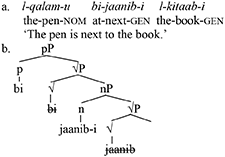
To account for the invariant accusative case assigned to jaanib-a “next” in (69c), Fassi Fehri (2021) assume an extra structural KP higher than the axial nP as in (74). The K head hosts the accusative case of the axial noun:
(74) 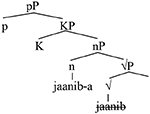
In the absence of the preposition, the axial noun is motivated to move to p according to the requirement imposed by the Edge of XP developed by Collins (2007), which goes back to the Doubly Filled Comp Filter (Chomsky and Lasnik, 1977):
(75) a. Edge(X) must be phonetically overt.
b. The condition in (a) applies in a
minimal way, so that either the head or
the specifier, but not both, are
spelled out overtly.
(Nchare and
Terzi,
2014, p. 694)
Based on (75), the axial locative noun jaanib-a “next to” in the absence of a preposition cannot remain in situ to ensure that condition (a) be minimally applied. It undergoes head movement to p, although not directly. Due to the Head Movement Constraint, it moves to the lower head K, then next to p.
Beside [+loc], there are other semantic features that can be associated with the locational root. Figure and Ground are associated to spatial configurations based on the relative Size and Stability (or Mobility) properties of F with respect to G (Landau and Jackendoff, 1993). As pointed out by Miller and Johnson-Laird (1976) and Talmy (1983), “if the objects are unequal in size and mobility, the larger and more stable is invariably encoded as the reference object [Ground]” (Landau and Jackendoff, 1993, p. 224). This is illustrated by the awkward status of the English (a) examples, or that of the Arabic (b) examples in (76) and (77):
(76) a. ?The table is under the book.
b. *l-maqʕad-u ʕalaa sutrat-i n-najaat -i
the-seat-NOM on jacket-GEN the-life-
GEN
Intended to mean: “The life jacket is under
the seat.”
(77) a. ?The garage is near the bike.
b. *l-masjid-u jaanib-a s-sayyarat-i
the-mosque-NOM next-ACC the-car-GEN
Intended to mean: “The car is next to the mosque.”
The oddness or ill-formedness of (76) and (77) has its source in the fact that F cannot be bigger in Size than G. Rather, the correct configurations are those exemplified in the following constructions:
(78) a. The book is on the table.
b. The bike is near the garage.
(79) a. sutrat-u n-njaat-i taḥt-a l-maqʕad-i
jacket-GEN the-life- under-ACC the-seat-
GEN GEN
“The life jacket is under the seat.”
b. s-sayyarat- jaanib-a l-masjid-i
u
the-car- next-ACC the-mosque-GEN
NOM
“The car is next to the mosque.”
However, we see at this point no reason that treat these features are syntactic (or morphosyntactic), in addition to being semantic, or conceptual, due to cognitive constraints that are grammaticalized.
3.2 AxPartPs
Axial or Axpart expressions, in addition to [loc], [Stab], and [Size], carry a vector space semantics (Zwarts, 1997; Zwarts and Winter, 2000). They denote sets of points occupied by G to some other regions or axes of the G such as its top, bottom, front, sides, etc. This axial property is identified syntactically as AxPart (Svenonius, 2006, 2010). In Arabic, axial expressions are categorized as nouns in most cases. They are identified not only semantically, but also syntactically. It is notable that what corresponds to English axial prepositions (over, under, behind, in front of, etc.) are in fact nouns in Arabic (fawq-a “over,” taḥt-a “under,” xalf-a “behind,” Ɂamaam-a “in front of”) that receive various cases, depending on their distribution. To illustrate, consider the following examples:
(80) a. Ɂanaa daaxil-a l-bayt-i
I inside-ACC the-house-GEN
“I am inside the house.”
b. Ɂanaa xalf-a l-baab-i
I behind- the-book-GEN
ACC
“I am behind the door.”
c. l-kitaab-u fawq-a ṭ-ṭaawilat-i
the-book-NOM above-ACC the-table-GEN
“The book is on the table.”
(81) a. Ɂanaa fii daaxil-i l-bayt-i
I in inside-GEN the-house-GEN
“I am inside the house.”
b. Ɂanaa fii xalf-i l-baab-i
I in behind-GEN the-book-GEN
“I am behind the door.”
c. l-kitaab-u min fawq-i ṭ-ṭaawilat-i
the-book- from above-GEN the-table-GEN
NOM
“The book is on the table.”
In (81), the axial expressions daaxil-a “inside”, xalf-a “behind”, and fawq-a “above” are the mere devices for the locational interpretation in the absence of a locative verb. Therefore, daaxil-a “inside”, xalf-a “behind”, and fawq-a “above” are endowed with a semantic/syntactic interpretable feature [loc]. Additionally, they are endowed with the features [Stab] and [Size], given the impossibility to select a Ground that is in motion or smaller than the Figure:
(82) a. *l-bayt-u xalf-a s-sayyarat-i
the-house-NOM behind- the-car-GEN
ACC
Intended to “The car is in front of the house.”
mean:
b. *ṭ-ṭaawilat-u fawq-a l-kitaab-i
the-table-NOM above-ACC the-book-GEN
Intended to “The book is on the table.”
mean:
The dual projections nP and √P in our account correspond to the single projection AxPart in Svenonius (2006, 2010) account, represented in (6) above, repeated here in (84b). For the sake of comparison, consider the English and Arabic pairs in (83) and their representations.
(83) a. Ɂaqif-u fii Ɂamaam-i l-bayt-i
stood-I in front-GEN the-house-GEN
“I stood in front of the house.”
b. I stood in front of the house.
(84) 
It is worth noting that the projection of KP does not seem to be supported in Arabic. While K, which in English lexicalizes “of,” holds a Possession relation between the Axial Parts and the Ground DP. The Arabic has no of-type Possession relation. The Arabic Possessor merges as a complement in a Construct State configuration, and not as high in the structure as the English synthetic Possessor (see Fassi Fehri, 1993 for detail about construct state possessives).
3.3 DegP
Locative expressions denote a distance on how far F is located with respect to G (see Herskovits, 1986; Koopman, 2000; den Dikken, 2006; Svenonius, 2010, 2012; Gärdenfors, 2015, among others). Some denote a far distance, endowed with the feature [Proj] such as fawq-a “over,” taḥt-a “under,” xalf-a “behind,” and Ɂamaam-a “in front of.” Others denote a near distance, endowed with the semantic features [Prox(imity)], such as jaanib “beside” and ʕind “at/by,” [Interpol(ation)] such as bayn “between,” or a zero distance, endowed with [Contact] or [Coincide], such as ʕalaa “on” and bi “in/at,” respectively. As is the case in English, Arabic makes a syntactic distinction between Proj and non-Proj expressions based on the tolerance to MeasP:
(85) a. We remained sixty feet in front of the palace.
b. *They opened the door one meter next to the stage.
(86) a. y-aqaʕu l-masjid- ʕalaa buʕd-i mitr-ayin xalf-a
u
3-locate the- on distance- meter- behind-
mosque- GEN DUAL. ACC
NOM GEN
l-bayt-i
the-
house-
GEN
“The mosque is two meters behind the house.”
b. *y-aqaʕu l-masjid- ʕalaa buʕd-i mitr-ayin jaanib-a
u
3-locate the- on distance- meter- next to-
mosque- GEN DUAL. ACC
NOM GEN
l-bayt-i
the-house-GEN
Intended “The mosque is two meters next to the house.”
to mean:
Further evidence that Proj is a syntactic feature in Arabic comes from the contrast between semantically related pair expressions such as fawq “above” and ʕalaa “on.” The Proj feature makes it possible for fawq “above” to collocate with far-distance denoting verbs such as ya-ṭiiru “fly” as in (87a), while in the same context ʕalaa “on,” which is [-Proj], cannot occur (87b).
(87) a. ta-ṭiiru ṭ-ṭaaɁirat-u fawq-a bayt-i-na
3F-fly the-plane- over-ACC house-GEN-
NOM our
“The plane is flying over our house.”
b. *ta-ṭiiru ṭ-ṭaaɁirat-u ʕalaa bayt-i-na
3F-fly the-plane- on house-GEN-
NOM our
Intended to “The plane is flying over our house.”
mean,
Additionally, the Contact feature associated with the non-Proj expressions provides the meaning of Support in spatial and non-spatial domains (Gärdenfors, 2015), which enables ʕalaa “on,” but not fawq “above,” to collocate with certain verbs such as ya-ʕtamid “rely,” yartakiz “depend/base:”
(88) a. y-aʕtamidu l-Ɂab-u ʕalaa bn-i-hi
3-rely the-father- on son-GEN-
NOM his
“The father relies on his son.”
b. y-artakizu r-rajul-u ʕalaa ʕaṣaa-hu
3-depend the-man- on stick.GEN-
NOM his
“The man depends on his stick.”
c. y-artakizu r-raʕ-u ʕalaa Ɂasaas-in ṣaḥiiḥ-in
3-base the- on ground- correct-
opinion- GEN GEN
NOM
“The opinion is based on a solid ground.”
(89) a. *y- l-Ɂab-u fawq-a bn-i-hi
aʕtamidu
3-rely the-father- over- son-GEN-
NOM ACC his
Intended to “The father relies on his son.”
mean:
b. *y-artakizu r-rajul-u fawq-a ʕaṣaa-hu
3-depend the-man- over- stick.GEN-
NOM ACC his
Intended to “The man depends on his stick.”
mean:
c. *y-artakizu r-raɁy-u fawq-a Ɂasaas-in ṣaḥiiḥ-in
3-base the- over- ground- correct-
opinion- ACC GEN GEN
NOM
Intended to “The opinion is based on a solid ground.”
mean:
Given that [Proj] and other features of the same kind are of syntactic feature in Arabic, we assume, following Svenonius (2010, 2012), that they are hosted under a separate projection, namely DegP. The latter is higher than PlaceP, but lower than pP. It is also higher than KP, leading to the following cartographic structure:
(90) 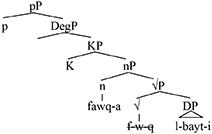
3.4 DeixP
A further interpretation expressed by the spatial expression is related to distality (distance from the speaker). The distal interpretation indicates different degrees of proximity to a deictic center (Svenonius, 2006). In Arabic, this distal information is introduced by the deictic locative adverb hunaa/hunaak, parallels English here/there:
(91) a. a few centimeters under (Svenonius, 2010, p. 140)
here
b. y- l- ʕalaa buʕd-i mitr- hunaa xalf-a
aqaʕu masjid- ayin
u
3- the- on distance- meter- here behind-
locate mosque- GEN DUAL.GEN ACC
NOM
l-bayt-i
the-house-GEN
“The mosque is two meters behind the house.”
Following Svenonius (2010), we assume that there is an additional a DeixP below DegP that hosts the deictic adverb hunaa “here.”
3.5 Directional paths
Directional expressions are cross-linguistically, distinguished from locational ones both semantically and syntactically (Jackendoff, 1983; Wunderlich, 1991; Zwarts, 1997, 2005; Koopman, 2000; Zwarts and Winter, 2000; Kracht, 2002; Gehrke, 2008; den Dikken, 2010; Svenonius, 2010). Semantically, they denote a direction of an intended motion, endowed with the feature [dir]. Syntactically, they cannot occur in static contexts as illustrated in English (2b) above, repeated here in (92a). We take the impossibility of directional to occur in the verbless sentence context like (92b) as a negative diagnostic for directional PPs in Arabic:
(92) a. *The box stayed/remained to/into/from/out
of/down/through the table.
(Gehrke, 2008, p. 87)
b. *Ɂanaa Ɂilaa /min/ xilaal- ṣawb-a l-bayt-i
a/
I to /from/ throu- /toward- the-
gh- house-
ACC ACC GEN
Lit: “I am from /thou- toward the house.”
to/ gh/
3.5.1 Complexity of dir PPs
It is generally agreed that directional preposition phrases, or Paths, are structurally complex because they embed Places. We argue that directional expressions are even more complex in Arabic than the widely accepted PathPs. One reason is that each projection of Path or Place root may surface as a preposition p or as a noun n as illustrated in (93):
(93) 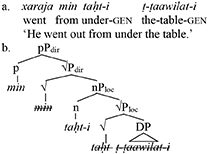
Another reason is related to Path expressions that surface as axial nouns (or AxPart) such as ʕabr-a “across,” ḥawl-a “around,” xilaal-a “through,” etc. More projections are required not only because they are syntactically nouns having an interpretable feature [+dir] that checks the uninterpretable feature [dir] of a higher probe p, but also because they are assigned a (oblique) case by a K head in the absence of a c-commanding preposition. For example, the directional expression ʕabr-a “across” in sentence (94a) can be represented in (94b):
(94) 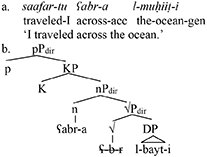
Additionally, if we follow Svenonius (2010), ʕabr-a “across” would be an extended (PathPlace) preposition, like across in English, meaning that it is a location head conflated with the directional head. Compare the English example in (95a) (Svenonius, 2010, p. 149), with the structure in (95b), to the representation of the Arabic ʕabr-a “across” in (96), as adapted to Arabic:
(95) 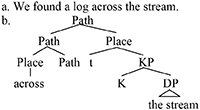
(96) 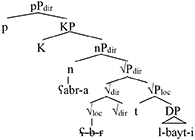
3.5.2 Transition and scale
Goal expressions Ɂilaa/li- “to” vs. ṣawb-a/naḥw-a/tujaah-a “toward” illustrated in (97) typically hold the same contrast between goal-oriented to and toward in English (98) (Evans and Tyler, 2004, p. 263):
(97) a. taḥarraka-t l-kurat-u Ɂilaa l-marmaa
moved-F the-ball- to the-
NOM goal.GEN
“The ball moved to the goal.”
b. taḥarraka-t l-kurat-u ṣawb-a l-marmaa
moved-F the-ball- towards- the-
NOM ACC goal.GEN
“The ball moved towards the goal.”
(98) a. He ran to the shop.
b. He ran toward the shop.
The semantic contrast between to and toward has been described as being relating to whether the trajectory does or doesn't reach the goal, respectively. In Kracht (2002) and Pancheva (2011) terminology, to has a transitional Goal (or Cofinal), whereas toward has non transitional Goal (or Approximative) Goal, each one bearing the feature [±TRANSITION]. Accordingly, the ball did reach the goal in (97a) but didn't in (97b). Similarly, with to, the trajectory (i.e. he) arrives at the shop in (98a), but with toward, sentence (98b), it does not entail that the trajectory (i.e., he) arrives at the shop. In Fassi Fehri's (2021) account, the contrast is attributed by the absence/presence of a semantic Mot(ion) feature in Ɂilaa/li- “to” vs. ṣawb-a/naḥw-a/tujaah-a “toward,” respectively. That makes the latter interpreted as being in motion. But the contrast between Ɂilaa/li- “to” and ṣawb-a/naḥw-a/tujaah-a “toward” could be equally attributed to the [±TRANSITION] feature opposition, in parallel to Pancheva's account.
Pancheva (2011) takes the transition opposition to be syntactically differentiated. She argues that the non-transition path expression toward in English is derived from the transition path to by having a higher scale head projecting ScaleP, and dominating GoalP, as represented in (99). The Scale head delimits the transition value, turning the goal expression into a non-transitional one:
(99) 
But despite the fact that in (99) Scale may seem to correctly explain the relation between the two morphemes to- and -ward in English, it doesn't seem to hold in Arabic. And although we agree with Procházka (2011) that toward is a complex head, we question that it is Scale. Since the the Mot(ion) feature described by Fassi Fehri (2021) is also semantico-syntactic, the contrast is between the directional Ɂilaa/li- “to” that can occur in static contexts and the motional ṣawb-a/naḥw-a/tujaah-a “toward,” which cannot tolerate stativity:
(100) a. t-ṭariiq-u Ɂilaa makkat-a muzdaḥim-
un
the-road- to Makkah- crowded-
NOM GEN NOM
“The road to Makkah is crowded.”
b. *ṭariiq-u ṣawb-a makkat-a muzdaḥim-
un
road-NOM toward- Makkah- crowded-
ACC GEN NOM
Intended to mean : “The road to
Makkah is crowded.”
Moreover, Ɂilaa “to” can select a directional-denoting expression such as yamiin “right” and yasaar “left,” resulting in a directional static interpretation, while ṣawb-a/naḥw-a/tujaah-a “toward” cannot:
(101) a. r-rajul-u waaqif-u-n Ɂilaa l-yamiin-i
the-man- standing- to the-right-
NOM NOM-N GEN
“The man is standing to the right.”
b. *r-rajul-u waaqif-u-n naḥw-a l-yamiin-i
the-man- standing- toward- the-right-
NOM NOM-N ACC GEN
Intended to mean: “The man is standing
to the right.”
We therefore suggest that the additional morpheme is Proc(ess), adopting Ramchand's (2008) terminology, rather than Scale. The construction in (101b) above is represented in (102). The presence of Proc explains why ṣawb-a/naḥw-a/tujaah-a “toward” cannot tolerate static contexts.
(102) 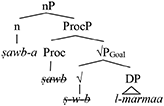
4 Conclusion
In this paper, we have provided a finer account of the syntactic and semantic complexity of basic Arabic spatial prepositional and axial noun phrases, as manifested in Places and Paths. As in DM architecture, we have separated root (or “lexical”) nodes from category (or functional) nodes, distinguishing √P (or “big”P) from (“small”) p, as in Larson's (1988, 2014) shell structure. We have provided essential ingredients allowing the decomposition of Place and Path words or expressions into √Ploc, √Pdir, or Pmot roots, in addition to Contain, Contact, or Coincide features, etc. Syntactic projections of AxPartP, DegP, DeixP, RouteP, GoalP, SourceP, and ProcP etc. have been supported and hierarchically ordered, following the lead of Svenonius's and Cinque's cartographies. Moreover, a detailed description of the basic prepositions and axial nouns in Arabic has been provided in the light of examining their syntactic and/or semantic features and their categories or projections, enabling appropriate analyses of their correlated alternations, polysemy, interacting features, as well as their variation across diverse colloquial dialects. Needless to say, more work has to be done, from a cross-linguistic comparative perspective, to see what patterns or construction types are more widespread, and how much allosemy or allomorphy is predictable through the model.
Data availability statement
The original contributions presented in the study are included in the article/supplementary material, further inquiries can be directed to the corresponding authors.
Author contributions
AF: Writing – review & editing, Writing – original draft, Project administration, Methodology, Investigation, Formal analysis, Data curation, Conceptualization. MA: Writing – review & editing, Writing – original draft, Project administration, Methodology, Investigation, Formal analysis, Data curation, Conceptualization.
Funding
The author(s) declare financial support was received for the research, authorship, and/or publication of this article. MA was partially supported by the King Abdulaziz University for presenting an earlier version of the paper at the 5th International Workshop on Syntactic Cartography (IWSC2023).
Acknowledgments
We would like to express our deepest gratitude to two reviewers for their insightful feedbacks and constructive remarks, which substantially improved the content of the article. An earlier version of the contribution was presented at the 5th International Workshop on Syntactic Cartography (IWSC2023) at Beijing, co-organized by the Department of Linguistics at Beijing Language and Culture University (BLCU), the International Association of Syntactic Cartographic Studies (IAOSCS) (Macao), and the Journal of Beijing International Studies University, 29-30 October 2023. We would like to thank the audience there for their fruitful comments, and we extend our thanks to Prof. Nadia Aamiri and Prof. Nuha Alshurafa for fruitful discussions.
Conflict of interest
The authors declare that the research was conducted in the absence of any commercial or financial relationships that could be construed as a potential conflict of interest.
Publisher's note
All claims expressed in this article are solely those of the authors and do not necessarily represent those of their affiliated organizations, or those of the publisher, the editors and the reviewers. Any product that may be evaluated in this article, or claim that may be made by its manufacturer, is not guaranteed or endorsed by the publisher.
Footnotes
1. ^For example, the two psych verb constructions in the following pair of examples are headed by verbal roots which are arguably monadic and dyadic roots, respectively, as shown in Fassi Fehri (2023, to appear):
(i) gaḍiba l-walad-u
anger-PAST the child-NOM
“The child angered; became angry.”
(ii) y-akrah-u l-walad-u t-tanaafus-a
3-hate-INDIC the-child-NOM the-competition-ACC
“The child hates the competition.”
Causativization of (ii) is possible, indicating that it is a basic transitive, whereas the causative of a derived transitive is ill-formed:
(iii) ʔ-akraha r-rajul-u l-walad-u t-tanaafus-a
CAUSE-hate-PAST the-man-NOM the-child-ACC the-
competition-
ACC
“The man caused the child to hate the competition.”
We assume that such option is also open for prepositions, without providing more detail here, due to space.
2. ^A cartography in the same spirit, but with more elaboration, is developed by Cinque (2010) as follows:
(i) [PPdir [PPstat [DPplace [DegP [ModelDirP [AbsViewP [RelViewP [RelViewP [DeicticP [AxPartP
[PP P [NPplace the table [PLACE]]]]]]]]]]]]]
(Cinque, 2010, p.8)
There is, however, one important difference between Svenonius” and Cinque”s cartographies in that the latter introduces a PLACE noun, which is essentially silent in English, and that a number of the functional projections of Svenonius are fused under PLACE (Kayne, 2004, 2007).
3. ^See fn. 5 below for detailed feature-based decomposition of Path PPs into eight subtypes in Pancheva (2011).
4. ^Among its less prototypical senses is CAUSATION taʕliil, as in (i)-(iii):
(i) qutila kulayb-u fii naaqat-in
killed.PASS Kulayb-NOM in cow-GEN
“Kulayb was (Jan, 2018, p.
killed for 133)
(steeling/losing)
a cow.”
A further meaning is ACCOMPANIMENT musaahaba:
(ii) xaraja l-Ɂamiir-u fii mawkib-in ḥaafil-in
went out the-prince- in procession- festive-GEN
NOM GEN
“The prince (Jan, 2018, p.
went out in a 133)
festive
procession.”
Yet another meaning is SUPERPOSITION stiʕlaaɁ:
(iii) ṣalaba-hum fii juḏuuʕ-I n-naxl-i
crucified-them in trunks-GEN the-palm
trees-GEN
“He crucified them on the trunks of palm trees.” (Jan, 2018, p. 134)
5. ^Other typical meanings of bi- include notably INSTRUMENT/MEANS, as in (i), or MANNER, as in (ii):
(i) ṭaʕana-hu bi-sikkiin-in
stabbed.3-him with-knife-GEN
“He stabbed him with a knife.”
(ii) ṭaʕana-hu bi-surʕat-in
stabbed.3-him with-quickness-GEN
“He stabbed him quickly.”
6. ^Note that the (b) examples are ungrammatical, although the two question marksindicate that they are only hardly acceptable, given interferences with colloquial dialects, in which the two prepositions are at variation. See Section 2.2.
7. ^Creissels notes that Heine's (1997) “companion schema” and Stassen's (2009) “with-possessive” and his “comitative-possessee” construction refer to possessive clauses glossable as “Possessor (is) with Possessee”, and that possessive maʕa clauses belong to the same oblique-possessor type as the possessive ʕinda- or li- clauses of Classical Arabic. In the original example, be is glossed “by”, but this preposition also has instrumental and comitative uses, and as the author rightly observes in the section where he describes the uses of be (p. 183), its use to flag the possessee in a possessive construction certainly derives from its comitative meaning. Consequently, in this example, the gloss “with” is more adequate.
References
Al-Muraadii, H. Q. (1992). Al-junaa al-daanii fii ?uruufi-l-ma?aanii. Beirut: Dar al Aafaaq. Available online at: https://archive.org/details/1249pdf_201912/page/n13/mode/2up (accessed August 15, 2020).
Bierwisch, M. (1996). “How much space gets into language?,” in Language and Space, eds. P. Bloom, M. Peterson, L. Needle, M.F. Garrettet (Cambridge, MA: MIT Press), 31–76. doi: 10.7551/mitpress/4107.003.0004
Chomsky, N. (2001). “Derivation by phase,” in Ken Hale: A Life in Language, ed. M. Kenstowicz (Cambridge, MA: MIT Press), 1–52. doi: 10.7551/mitpress/4056.003.0004
Cinque, G. (2010). “Mapping spatial PPs: an introduction,” in Mapping Spatial PPs. The Cartography of Syntactic Structures 6, eds. G. Cinque, L. Rizzi (New York: Oxford University Press), 3–25. doi: 10.1093/acprof:oso/9780195393675.003.0001
Creissels, D. (2022). Existential predication and predicative possession in Arabic dialects. STUF 75, 583–612. doi: 10.1515/stuf-2022-1064
Deacon, R. J. (2011). P-forms in distributed morphology: accounting for a type of semilexical form. MA thesis, University of Florida, Gainesville.
Demirdache, H., and Uribe-Etxebarria, M. (2014). Aspect and temporal anaphora. Nat. Lang. Linguist. Theor. 32, 855–895. doi: 10.1007/s11049-014-9231-2
den Dikken, M. (2003). On the syntax of locative and directional adpositional phrases. Ms. City University of New York, New York.
den Dikken, M. (2006). On the functional structure of locative and directional PPs. Ms. City University of New York, New York.
den Dikken, M. (2010). “On the functional structure of locative and directional PPs,” in Mapping Spatial PPs: Cartography of Syntactic Structures, eds. G. Cinque, L. Rizzi (Oxford: Oxford University Press), 74–126. doi: 10.1093/acprof:oso/9780195393675.003.0003
Embick, D., and Noyer, R. (2005). “Distributed morphology and the syntax/morphology interface,” in The Oxford Handbook of Linguistic Interfaces, eds. G. Ramchand, C. Reiss (Oxford: Oxford University Press), 289–324.
Esseesy, M. (2010). Grammaticalization of Arabic Prepositions and Subordinators: A Corpusbased Study. Leiden: Brill. doi: 10.1163/9789004187634
Evans, V., and Tyler, A. (2004). “Rethinking English “prepositions of movement”: the case of to and through,” in Adpositions of Movement, eds. H. Cuyckens, W. de Mulder, T. Mortelmans (Amsterdam: John Benjamins), 247–270. doi: 10.1075/bjl.18.13eva
Fassi Fehri, A. (1993). Issues in the Structure of Arabic Clauses and Words. Dordrecht: Kluwer. doi: 10.1007/978-94-017-1986-5
Fassi Fehri, A. (2023). “Psych construction types in Arabic as root-based,” in Paper presented at SLE 56 (Athens: University of Athens).
Fassi Fehri, A., and Alrawi, M. (2023). Arabic PPs in a rooted lexicon. Languages 8, 1–23. doi: 10.3390/languages8020095
Gärdenfors, P. (2015). The geometry of preposition meanings. Baltic Int. Yearb. Cogn. Logic Commun. 10, 1–18. doi: 10.4148/1944-3676.1098
Gehrke, B. (2008). Ps in motion: On the semantics and syntax of P elements and motion events. LOT Dissertation Series, Netherlands Graduate School of Linguistics, Utrecht.
Hale, H., and Keyser, S. J. (2002). Prolegomenon to a Theory of Argument Structure. Cambridge, MA: MIT Press. doi: 10.7551/mitpress/5634.001.0001
Hale, K. (1986). “Notes on world view and semantic categories: some Warlpiri examples,” in Features and Projections, Studies in Generative Grammar 25, eds. P. Muysken, H. van Riemsdijk (Dordrecht: Foris), 233–254. doi: 10.1515/9783110871661-009
Halle, M., and Marantz, A. (1993). “Distributed morphology and the pieces of inflection,” in The View from Building 20, eds. K. Hale, S. J. Keyser (Cambridge, MA: MIT Press), 111–176.
Harley, H. (2002). Possession and the double object construction. Ling. Variat. Yearb. 2, 29–68. doi: 10.1075/livy.2.04har
Heine, B. (1997). Possession: Cognitive Sources, Forces and Grammaticalization. Cambridge: Cambridge University Press. doi: 10.1017/CBO9780511581908
Herskovits, A. (1986). Language and Spatial Cognition: An Interdisciplinary Study of the Prepositions in English. Cambridge: Cambridge University Press.
Ibn Hišaam, J. (1985). Mugnii l-labiib, 6th Edn. [14th C.]. Cairo: Al-Madani Publishers. Available online at: https://archive.org/details/moharram1965_gmail_20180428/page/n339/mode/2up (accessed March 20, 2020).
Jahfa, A. (2011). “Verbs of recipient and content,” in Arabic Issues in Arabic Linguistics, eds. A. Khayri, A. Jahfa, and A. Rachad. (Casablanca: Faculty of Arts and Human Sciences), 11–28.
Jan, H. (2018). A cognitive linguistic approach to explaining the polysemy of ‘alaa and fii in Modern Standard Arabic. PhD thesis, Georgetown University, Washington, D.C.
Kayne, R. S. (1993). Toward a modular theory of auxiliary selection. Stud. Ling. 47, 3–31. doi: 10.1111/j.1467-9582.1993.tb00837.x
Kayne, R. S. (2004). “Prepositions as probes,” in Structures and Beyond, ed. A. Belletti (New York: Oxford University Press), 192–212. (reprinted in Kayne (2005)). doi: 10.1093/oso/9780195171976.003.0006
Kayne, R. S. (2007). “On the Salient Absence of You are to be home by midnight in Italian Dialects (and Various Other Languages),” in paper presented at the 2nd Cambridge Italian Dialect Syntax Meeting (Cambridge, England).
Koopman, H. (2000). “Prepositions, postpositions, circumpositions, and particles,” in The Syntax of specifiers and Heads, ed. H. Koopman (London: Routledge), 204–260. doi: 10.4324/9780203171608
Kracht, M. (2002). On the semantics of locatives. Ling. Philos. 25, 157–232. doi: 10.1023/A:1014646826099
Kracht, M. (2008). “The fine structure of local expressions,” in The Structure of Local P, eds. A. Asbury, J. Dotlačil, B. Gehrke, R. Nouwen (Amsterdam: John Benjamins), 35–62.
Landau, B., and Jackendoff, R. (1993). “What” and “where” in spatial language and spatial cognition. Behav. Brain Sci. 16, 217–265. doi: 10.1017/S0140525X00029733
Larson, R. K. (2014). On Shell Structure. New York and London: Routledge. doi: 10.4324/9780203429204
Lentzner, K. (1977). Semantic and syntactic aspects of Arabic prepositions. Doctoral dissertation, Georgetown University, Washington, D.C.
Manfredi, S. (2010). A grammatical description of Kordofanian Baggara Arabic. PhD thesis, Università degli Studi di Napoli L”Orientale, Naples.
Marantz, A. (1997). No escape from syntax: don't try morphological analysis in the privacy of your own lexicon. University of Pennsylvania Working Papers in Linguistics, 201–225.
Marantz, A. (2013). “Locality domains for contextual allomorphy across the interfaces,” in Distributed Morphology Today: Morphemes for Morris Halle, eds. O. Matushansky, A. Marantz (Cambridge, MA: MIT Press), 95–116. doi: 10.7551/mitpress/9701.003.0008
Miller, G. A., and Johnson-Laird, P. N. (1976). Language and Perception. Cambridge, MA: Belknap Press. doi: 10.4159/harvard.9780674421288
Nam, S. (1995). The Semantics of Locative Prepositional Phrases in English. Los Angeles: University of California.
Nchare, A., and Terzi, A. (2014). Licensing silent structure: the spatial prepositions of Shupamem. Nat. Lang. Ling. Theory 32, 673–710. doi: 10.1007/s11049-014-9230-3
Pancheva, M. (2011). Decomposing path: the nanosyntax of directional expressions. PhD thesis, University of Tromsø, Norway.
Piñón, C. J. (1993). “Paths and their names,” in Chicago Linguistics Society 29 Beals, eds. K., Cooke, G., Kathman, D., Kita, S., McCullough, K., D. Testen (Chicago: Chicago Linguistics Society), 287–303.
Procházka, S. (1993). “Some remarks on the semantic function of the reduplicated quadrilateral verbs (structure fa3fa3a),” in Proceedings of the Colloquium on Arabic Lexicology and Lexicography 1, eds. D. Kinga, T. Ivanyi (Budapest: Eotvos Lorand University and Csoma de Koros Society), 97–103.
Ramchand, G. (2008). Verb Meaning and the Lexicon. New York: Cambridge University Press. doi: 10.1017/CBO9780511486319
Rooryck, J. (1996). “Prepositions and minimalist case marking,” in Studies in Comparative Germanic Syntax II, eds. H. Thrainsson, S. D. Epstein, and S. Peter (Amsterdam: Kluwer), 226–256. doi: 10.1007/978-94-010-9806-9_9
Saad, A. (2019). “Les pseudo-verbes dans le dialecte de Benghazi: valeurs possessives et non possessives,” in Studies on Arabic dialectology and sociolinguistics: Proceedings of the 12th international conference of AIDA, eds. C. Miller, A. Barontini, M. Germanos, J. Guerrero, C. Pereira (Aix-en-Provence: Institut de recherches et d'études sur les mondes arabes et musulmans), 232–244. doi: 10.4000/books.iremam.4755
Saeed, S. (2014). The syntax and semantics of Arabic spatial Ps. Newcastle and Northumbria Working Papers in Linguistics, 44–66.
Stassen, L. (2009). Predicative Possession. Oxford: Oxford University Press. doi: 10.1093/oso/9780199211654.001.0001
Svenonius, P. (2010). “Spatial P in English,” in Mapping Spatial PPs, The Cartography of Syntactic Structures, eds. G. Cinque, L. Rizzi (Oxford: Oxford University Press), 127–160. doi: 10.1093/acprof:oso/9780195393675.003.0004
Svenonius, P. (2012). Structural decomposition of spatial adpositions. Ms. Universitetet I Tromsø, Norway.
Taine-Cheikh, C. (2008). “De l”expression de la cause et de la causalité dans l”arabe de Mauritanie,” in Between the Atlantic and Indian oceans: Studies on contemporary Arabic dialects. Proceedings of the 7th AIDA, eds. S. Procházka, V. Ritt-Benmimoun (Vienna: LIT-Verlag), 423–436.
Talmy, L. (1975). “Semantics and syntax of motion,” in Syntax and Semantics, ed. J. Kimball (New York: Academic Press), 181–238. doi: 10.1163/9789004368828_008
Talmy, L. (1983). “How language structures space,” in Spatial Orientation: Theory, Research and Application, eds. H. L. Pick, L. P. Acredolo (New York: Plenum Press), 225–282. doi: 10.1007/978-1-4615-9325-6_11
Talmy, L. (2000). Towards a Cognitive Semantics: Typology and Process in Concept Structuring. Cambridge, MA: MIT Press. doi: 10.7551/mitpress/6848.001.0001
Wood, J., and Marantz, A. (2017). “The interpretation of external arguments,” in The Verbal Domain, eds. R. D'Alessandro, I. Franco, Á. J. Gallego (Oxford: Oxford University Press), 255–78. doi: 10.1093/oso/9780198767886.003.0011
Wunderlich, D. (1991). How do prepositional phrases fit into compositional syntax and semantics? Linguistics 29, 591–621. doi: 10.1515/ling.1991.29.4.591
Zwarts, J. (1997). Vectors as relative positions: a compositional semantics of modified PPs. J. Semant. 14, 57–86. doi: 10.1093/jos/14.1.57
Zwarts, J. (2005). Prepositional aspect and the algebra of paths. Ling. Philos. 28, 739–779. doi: 10.1007/s10988-005-2466-y
Zwarts, J. (2008). “Priorities in the production of prepositions,” in Syntax and Semantics of Spatial P, eds. A. Asbury, J. Dotlačil, B. Gehrke, R. Nouwen (Amsterdam/Philadelphia: John Benjamins Publishing Company), 85–102.
Keywords: prepositions, Axial Parts, Place, Path, P, Distributed Morphology, Arabic
Citation: Fassi Fehri A and Alrawi M (2024) Motivating a fine-grained syntax of Arabic prepositional phrases. Front. Lang. Sci. 3:1360562. doi: 10.3389/flang.2024.1360562
Received: 04 January 2024; Accepted: 17 May 2024;
Published: 12 June 2024.
Edited by:
Maris Camilleri, University of Essex, United KingdomReviewed by:
Peter Hallman, Austrian Research Institute for Artificial Intelligence, AustriaHassan Banaruee, University of Education Weingarten, Germany
Copyright © 2024 Fassi Fehri and Alrawi. This is an open-access article distributed under the terms of the Creative Commons Attribution License (CC BY). The use, distribution or reproduction in other forums is permitted, provided the original author(s) and the copyright owner(s) are credited and that the original publication in this journal is cited, in accordance with accepted academic practice. No use, distribution or reproduction is permitted which does not comply with these terms.
*Correspondence: Abdelkader Fassi Fehri, YWJkZWxrYWRlcmZhc3NpZmVocmlAZ21haWwuY29t; Maather Alrawi, TWFhdGhlci5hbHJhd2lAZ21haWwuY29t
†These authors have contributed equally to this work and share first authorship
 Abdelkader Fassi Fehri
Abdelkader Fassi Fehri Maather Alrawi
Maather Alrawi